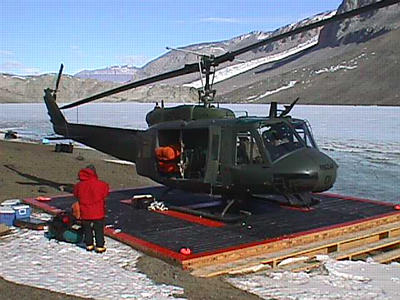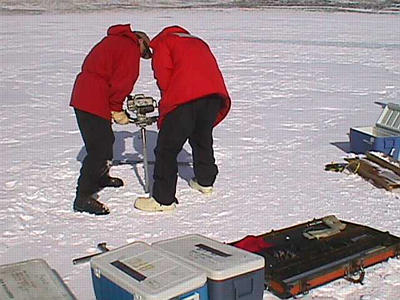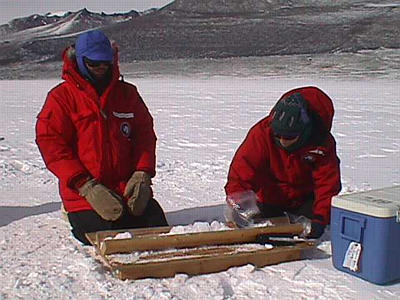
|
|
17 November, 1998
Today our main goal was to do some ice coring at Lake Vida, another lake
in the Dry Valleys. My team is trying to get as many samples as
possible so that they have a lot to work with when they're doing
experiments. They are trying to compare the similarities and
differences among the various lakes. What makes them different? What
makes them the same? Are the same organisms found at each lake? The
locations of the lakes are very different, obviously, but the surfaces
are very different (some are very rough, some are relatively smooth).
Some lakes have ice full of bubbles; some lakes have the clear, dark
blue ice that you can see great distances through. It's interesting to
see how different each lake's ecosystem is.
I woke up at 7:30 am and checked my e-mail before breakfast. I packed a
day pack for the trip to Lake Vida (water bottle, pee bottle...that's
what they're called!, snacks, and sample bottles...in case we find any
sediments we want to sample). At 10:30 the Kiwi helicopter arrived and
dropped off another visitor, a Boy Scout named Ben Hasse. He was
selected from many Boy Scouts for the honor of traveling to Antarctica
to visit all of the stations and scientists down here. He just returned
from a trip to the Pole, and now he'll be with my team until Saturday
when everyone is returning to McMurdo for the weekend.
Mark and Chris are joining us for the day to help us collect samples.
So, John, Chris, Nina, Mark, and I were on our way to Lake Vida for the
day. We arrived around 11:00 am and immediately began coring. The
weather was extremely nice...very warm and sunny. We cored for about an
hour and realized that we really weren't getting good cores...the ice
was crumbling into smaller puck sizes, rather than long sections of
cylindrical ice. To core ice, we use a long cylindrical metal tube with
spiral cuts on the outside and a drill bit on the bottom (to cut into
the ice). On top of the cylinder, we place a power head (basically an
engine...you start it like you would a generator or a lawn mower...by
pulling the cord). The power head causes the cylinder to turn, and
hopefully, by pushing down on the cylinder barrel, we can take cores of
ice out of the lake. [Today it wasn't working very well.] The ice core
samples are then gently tapped into a relatively clean trough so that
they can be bagged, labeled, and placed into a cooler for transportation
back to the Crary Lab freezers at McMurdo.
We ate our boxed lunches that Chris had brought from the Galley at
McMurdo. We decided to try a couple more cores to see if it mattered
where we were coring. This took us until about 3:30 pm. As we rotated
jobs, we had to keep warm, so we played "Keep Away" with some duct
tape. That ended when Mark got hurt...he pulled a muscle. Actually,
after that it really warmed up. The wind stopped and that's when my
temperature gauge on my jacket fluctuated between 40 and 50 degrees F!
We took layers off and decided to go for a walk to the stream bed (which
was about a 45-minute walk from where we cored) to gather algae
samples. We found huge algal mats lying in the snow off-shore.
Remember I said that the algae is easier to find in meltwater areas?
That's where we found them...in the dirty snow that was half-melted.
At 5:00 pm the helicopter picked us up to take us back to Lake Bonney.
On the way, we stopped at Marble Point to refuel (just a
home-away-from-home for fueling). Ed made us halibut steaks, boiled
cabbage, and broccoli/cheese rice...very good! Being out all day made
me tired, so I went to bed around 10:30, a little earlier than the last
few nights.

The Kiwi helicopter picking us and our equipment up for our Lake Vida ice coring trip.

Chris (left) and Mark (right) coring. You can't see the actual coring barrel. It's farther down under the surface of the ice. What you see is an extension to allow the barrel to go further under the surface.

Mark and Nina bagging the core that has been tapped into the trough. The bag is labeled with the number core, the lake name, the depth of the core, and the date.

Nina (right) and I goofing off at Lake Vida. Note that we are down to our last layer of clothing...it was really warm out there in the afternoon...no wind.
Contact the TEA in the field at
.
If you cannot connect through your browser, copy the
TEA's e-mail address in the "To:" line of
your favorite e-mail package.
|
